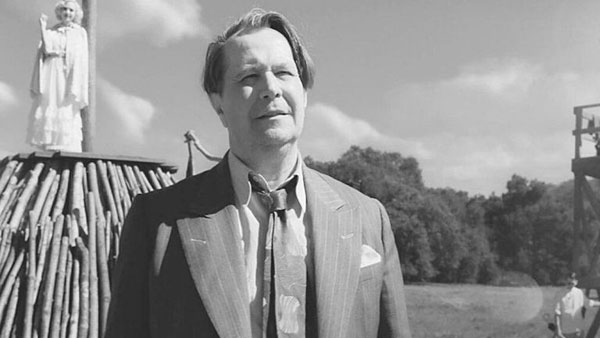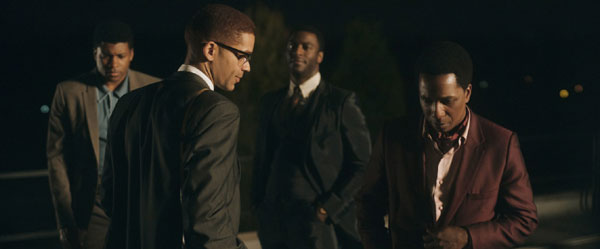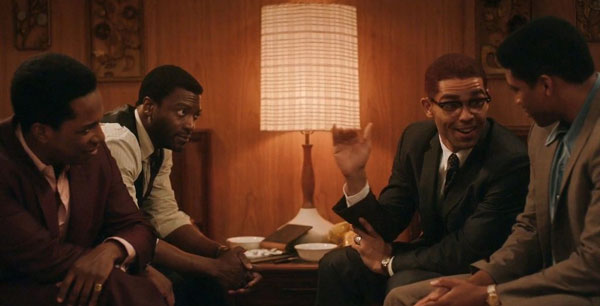|
Encounters between historical characters are, of course, a staple of drama. Of necessity, playwrights and screenwriters must invent most
or all of the dialogue in imagining those meetings, and often some characters as well, Falstaff being the most famous. Two recent films—David Fincher's Mank, on Netflix,and Regina King's One Night in Miami, on
Amazon Prime—are examples of what directors, writers and actors can do when they take authentic historical events and, knowing what they do of the people involved, create
fictions that audiences can accept as having the ring of truth.
Featuring a screenplay by Fincher's father, the late Jack Fincher, Mank begins with Herman J. Mankiewicz (Gary Oldman) arriving at a
remote cabin in the California desert to write a screenplay for the movies' new Wunderkind, Orson Welles (Tom Burke). Immobilized by a broken leg, Mank is policed by
secretary Rita Alexander (Lily Collins) and nurse Fraulein Freda (Monika Gossmann), while John Houseman (Sam Troughton), Welles' second-in-command, leans on Mank to produce a
workable script within a tight deadline. A large part of that for Houseman is to keep him away from the bottle.
Mankiewicz and Welles shared credit for the resulting screenplay, which became Citizen Kane, and also shared the Oscar that screenplay
won. To this day, it is a fraught question as to how much credit Welles deserved for it. In her famous essay on the movie, Pauline Kael took the word of Houseman and
Alexander that Mankiewicz was sole author. But as Sonia Rao noted in a recent Washington Post article, Welles' friend Peter Bogdanovich quoted Welles as saying, "I
used what I wanted of Mank's (work) and, rightly or wrongly, kept what I liked of my own." Subsequent film scholars give credence to Welles, using their own extensive
research to back their opinion. But Mankiewicz, one of the most celebrated wits in Hollywood history, begged to differ. He quipped that if he had attended the Oscar
ceremony, his speech would have been, "I am very happy to accept this award in Mr. Welles' absence because the script was written in Mr. Welles' absence."

It is no surprise that Mank argues in Mankiewicz's favor. However, as with
most movies that concern historical figures and events, the film isn't exactly a documentary. As the New York Times reported, there is plenty of
evidence that William Randolph Hearst (Charles Dance) and Louis B. Mayer (Arliss Howard) worked to undermine the 1934 gubernatorial
candidacy of Upton Sinclair (Bill Nye), but none that Mankiewicz took any role in the campaign, for or against. Shelly Metcalf (Jamie McShane), the
ardent Sinclair supporter, is an invented character. Nevertheless, the plot device of the Sinclair campaign gives Mank a reason to seek vengeance
against Hearst, as well as reinforcing his image as a permanent Hollywood outsider. (That Mank hated Mayer is a matter of historical record. "If I am
ever sentenced to the electric chair," the screenplay quotes him as saying, "I want Louis B. Mayer to sit in my lap.")
Mank is yet another tour de force for Oldman, whose Herman Mankiewicz
is a classic self-destructive Hollywood eccentric. His drinking and gambling are so reckless that his wife Sara (Tuppence Middleton) is
routinely referred to as "Poorsara." He survives only because his wit and brilliance match his profligacy. Fincher makes that point early on, with a
scene set in the MGM writers' bullpen in which Mank outshines an assemblage of wits including George S. Kaufman (Adam Shapiro), S.J.
Perelman (Jack Romano), Charles McArthur (John Churchill) and Ben Hecht (Jeff Harms). Newbie Charles Lederer (Joseph Cross) walks in.
"Have you been laid yet?" Mank asks Lederer. Lederer is nonplussed and silent. "Did you have to think about that?" Mank asks.
A platoon of Hollywood legends parades through Mank as supporting characters, but even Hearst and Welles are in the shadows, more eminences
grises than fully fleshed characters. The most important supporting character is Marion Davies (Amanda Seyfried). Davies was aunt to Charles
Lederer and—more to the point—the longtime mistress of Hearst and ostensible model for Susan Alexander Kane. As portrayed in the film,
Davies is a platonic friend to Mank, a sensible and spirited observer of Hollywood who genuinely loves Hearst. Davies is nothing like Susan, and
Mank's need for Susan as a foil to Charles Foster Kane begs the question of what is allowable in fictionalizing the lives of real people. That is an
interesting question for Fincher too—one he considers, but only briefly and scarcely definitively.
Generally speaking,Mank is a persuasive film. Visually it is a match for the
film it celebrates, thanks to the crisp black-and-white photography of Erik Messerschmidt and the elegant production design of Donald Graham Burt. Unfortunately, Mank in the end feels academic, more thought than felt. Citizen Kane has been accused of being the same, but Mank doesn't possess
the same level of kinetic excitement as Kane. It is a smooth, slightly detached entertainment, graced by fine performances, especially Oldman's.
For an equally smooth but more impassioned film, there is One Night in Miami—the feature film directing debut for King, who won a Best
Supporting Actress Oscar for If Beale Street Could Talk.

Featuring a screenplay by Kemp Powers from his own stage play, One Night in Miami presents a persuasive scenario for the historically factual
meeting on Feb. 25, 1964 between four renowned Black men: Malcolm X (Kingsley Ben-Adir), soul singer Sam Cooke (Leslie Odom Jr.), football
great Jim Brown (Aldis Hodge), and the man who at that point was still known as Cassius Clay (Eli Goree).
Feb. 25, 1964 was perhaps the most important day in Clay's life. That
evening he pulverized Sonny Liston to become Heavyweight Champion of the World. But Clay was on the verge of an even more momentous event:
under the mentorship of Malcolm, he planned to join the Nation of Islam and recreate himself as Muhammad Ali.
Nevertheless, Clay/Ali was not yet aware of Malcolm's equally dramatic decision to leave the Black Muslims, denounce Elijah Muhammad, and join
the larger community of Islam.
One Night in Miami conjures a believable, often fiery dialogue between the
four men, set in Malcolm's motel room after the Clay-Liston bout. According to King and Powers, that fight had nothing on the fight that
took place in Malcolm's room. What happened there, the film tells us, was a pointed debate on how African-Americans could gain personal, economic,
and political power in a society hellbent on denying it to them.
The crux of the screenplay is the argument between Malcolm and Cooke.
Malcolm accuses Cooke of diluting his music, and the message behind his music, for white audiences. "You're just a wind-up toy in a music box—a
monkey dancing for an organ grinder!" Malcolm yells at Cooke. Cooke replies that the best way to gain power is to beat the oppressors at their
own game. "Everybody talks about having a piece of the pie!" he says. "I don't! I want the goddamn recipe!"
Brown, who himself is on the brink of a momentous decision—leaving
football for the movies—is furious that Malcolm and Cooke have soured what promised to be a celebratory evening. "You're pulling out the knives, and if I get cut, I'm fixing to hurt somebody!" he says. But his anger is
nothing compared to Clay's when he learns that Malcolm, after recruiting him for the Nation of Islam, is preparing to leave it.

There are numerous supporting players in One Night in Miami, including
Michael Imperioli as Clay's trainer Angelo Dundee; Joaquina Kalukango as Malcolm's wife Betty; Lance Reddick as Kareem, Malcolm's menacingly
devoted bodyguard; and Beau Bridges as a white plantation owner who praises Brown only to humiliate him. But it is the four leads who have the
lion's share of the movie, and they are marvelous. We see each of these legendary men at a crucial point in his life, and our knowledge of their
subsequent fates adds both bite and poignancy to the stiletto-sharp dialogue Powers gives them. Ben-Adir has the best role of the four; we
aren't used to seeing a sad, vulnerable Malcolm, as Ben-Adir presents him in the film's most moving moments, and it catches the audience off guard. I
should also add that Odom, who became a star as Aaron Burr in Hamilton, is every bit as fine a singer as the historical character he plays.
King gives One Night in Miami an opulent sheen with the help of cinematographer Tami Reiker and production designers Barry Robison and
Page Buckner. Altogether, One Night in Miami is a riveting story about four men at a crossroads. It goes without saying that their nation had
reached the same crossroads. Nearly six decades later, there are those who make it their lives' work to take America backwards from that crossroads,
and that makes the message of One Night in Miami all the more urgent.
|